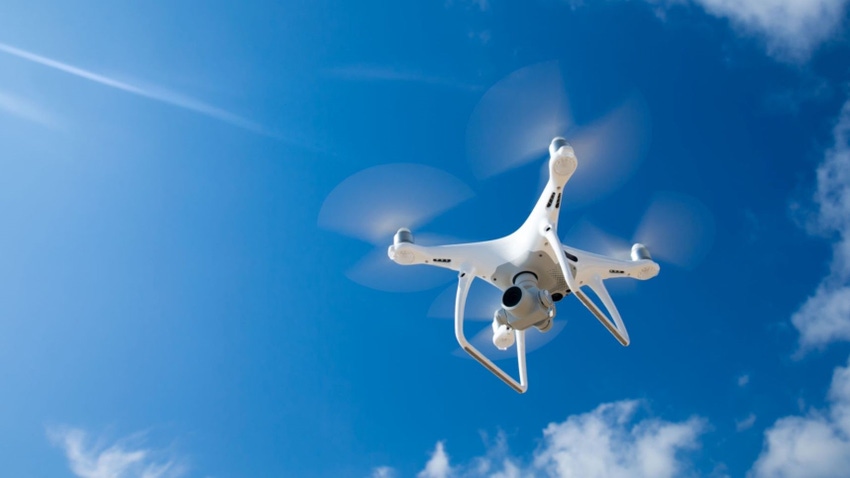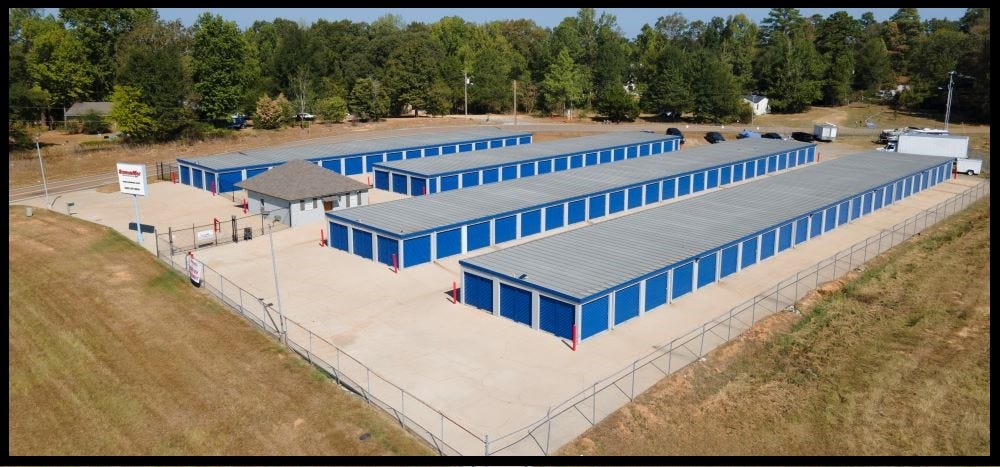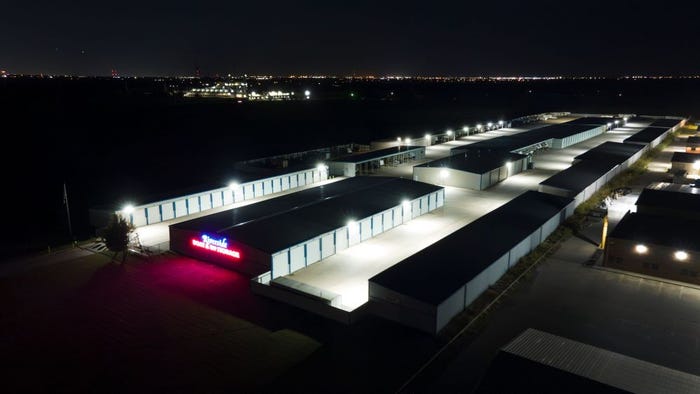10 Guidelines for Successfully Using Drone Technology in Your Self-Storage Marketing
Many self-storage operators today are using drones to take facility photos and video for marketing purposes. It’s a smart strategy. However, you can’t just send the technology into the air and hope for the best. You need an experienced pilot who can capture your site’s best features and deliver usable content. Here are 10 guidelines to help you achieve the best outcome.
January 16, 2024

They say a picture is worth a thousand words, but what about one taken by a drone? I’d argue it has even greater value. When photographing a self-storage facility from the ground, it takes several shots to show the variety of unit sizes, driveways, lights, cameras, fencing, vehicle parking and curb appeal. But a drone picture can tell that whole story with a single take.
So, how do you get that perfect photo? Can you just buy a drone and play around with it? Not if you want the best results. For those you need an experienced pilot who knows the rules, the industry and how to deliver great footage. Below are 10 guidelines to follow when considering drone media for your marketing arsenal. From licensing to weather to editing, there’s a lot to bear in mind. However, if you follow these steps, you should have exactly what you need to tell the story of your self-storage facility.
1. Hire a licensed drone pilot.
Believe it or not, flying a drone is regulated by the Federal Aviation Administration (FAA). While these machines are readily available to be purchased by just about anyone, it isn’t as simple as buying one, launching it into the air and taking a few photos. If a drone is used for anything other than a hobby, no matter its size, the individual flying it must have an FAA Part 107 license. The drone must also be registered with the FAA and equipped with a remote ID.
Now, if you go around this rule, will an FAA agent swoop down and fine you? Maybe, maybe not. If you drive your car without a license, will the police immediately pull you over? Maybe, maybe not. But this is about more than just having the right credentials and following the rules.
A licensed drone pilot has the training and expertise to ensure footage is gathered safely and legally. They know what type of airspace they’re flying into and often can get clearance for places prohibited to others. They’ve been trained in weather dynamics and can avoid conditions that could lead to a loss of drone control. They also know the proper safety measures to keep people on the ground out of harm. Plus, the footage gathered is usable for commercial purposes, like marketing your self-storage facility, so you never have to worry about violating those particular rules now or in the future.

StorageMax in Flowood, Mississippi
2. Before you hire, see your pilot’s portfolio and equipment.
A drone pilot should have the experience and tools to provide the services you need. Ask your candidate if they’ve recorded commercial properties, and ask to see examples of their work. Have they taken photos? Videos? Worked after dark? Your storage facility shouldn’t be the first in this person’s portfolio.
The right drone can also make a huge difference. Most professional machines will take fantastic shots, so make sure your pilot has the right tool for the job. If they’re shooting with a drone that cost less than $100 and was purchased at the local big-box store, it might not be up to the task. Professional drones will be able to handle a windy day and still take high-definition photos and videos. So, ask about the pilot’s equipment and do a little research. Trust me, it’ll be time well spent.
3. Be specific about your needs.
There are many uses for drone footage. You might desire a new art header for your self-storage website, a variety of shots to spruce up your Google profile, or detailed photos of your roof for an upcoming maintenance project. You know these things, but your pilot doesn’t, especially if they haven’t taken footage of a storage facility before (more on that below).
Make sure your pilot knows what you need. Do you want a slow-moving video to put at the top of your website? Photos that capture your surveillance cameras? Close-ups of your pole lights? A shot list is a handy thing to give to your pilot, especially if you have specific requirements.
4. Be flexible around weather.
Weather is a huge consideration for a drone pilot. There are several modules during flight training that cover weather patterns and how to fly safely in every environment. There are also specific types of weather in which flying a drone is prohibited.
When you’re setting up a time with your pilot, it’s good to have a backup day in mind just in case the weather is bad. Even a cloudy day can ground the flight. Your pilot has no control over this, so be patient and plan to work with them to have the best conditions possible.
5. Make sure the footage is the right quality.
I’m amazed at the quality of images captured by tiny drone cameras. The higher the quality, the better the photo, right? Most of the time I’d agree; however, there can be drawbacks. Typical drone images can range from 6MB to 10MB and even higher depending on the camera settings. An image of just 1MB can slow your website load time. You don’t want a pixelated image, but you also don’t want something that’ll bog down your platforms.

Riverside Boat & RV Storage in Newcastle, Oklahoma
Video is a different story. There, I wouldn’t skimp on quality. Most social platforms will lower video quality as the file is uploaded, so get the best you can. High definition and 4K footage allows for zooming in if necessary. Also, get several shorter-length videos that are more friendly for websites and social media rather than one or two longer ones.
Quality is also about the kind of footage you get. Do the photos have the right lighting? Is your entire self-storage facility in the shot? Are key features missing? Is the video jerky or shaky as the drone flies around? An experienced pilot will be able to deliver smooth and clear footage of your entire property.
6. Choose a pilot with experience in self-storage.
Our unique industry is unique. Shooting a self-storage facility isn’t like working in a home or retail environment. Our customers want to see how wide the driveways are for their rental truck, what security features are on site and the layout of the buildings. They want to know their goods will be safe on a property that’s well-maintained.
The question is, does your drone pilot know this? Do they know the particular things about our business that need to be featured? You can give them a detailed shot list, but you aren’t a pilot or movie director. The person you hire should already know what makes a self-storage facility enticing to viewers. Your property is loaded with showcase-worthy features. Experience will ensure they aren’t missed.
7. Highlight all facility features.
Don’t forget to capture everything! You have a unique perspective on what makes your self-storage facility great. Maybe it’s the goose-neck lighting or the water fountain in front of your office, or outstanding architecture or curb appeal. But there are also many mundane extras your customers need to see. They want to know your facility is fenced, has cameras mounted on the buildings, and where the kiosk is located. They need to see that your roofs are in good condition, your gravel driveways don’t have divots and the grass has been cut.
Your photos and videos should highlight everything about your property that’ll invite someone to store with you, during the day and at night. If you have great lighting, see if your pilot can come back after dark to showcase it.
Your drone pilot will only be on site for a few hours at most, so make sure they capture it all. If there’s something you’re particularly proud of, be sure to mention it.
8. Acquire properly edited media.
Drones capture photos and video in amazing detail. The videos are especially mesmerizing. But that quality comes at the cost of extremely large files. A 4K or 8K video can be several hundred megabytes for less than 60 seconds of footage.
The size and quality of all your drone media really matters. Most of the time, some editing is required to convert the raw footage into useable files. Often there are a few seconds at the beginning or end that are unusable as the drone lines up its shot or your self-storage facility leaves the frame. At the end of the project, will you have pictures and video that are ready to use, or will you have to enlist someone else to create that short video, brighten up those pictures, or photoshop those annoying telephone lines that are in every shot?

Little Vine Storage in Villa Rica, Georgia
Solid editing can make all the difference. Small changes in lighting or the addition of background music or a logo can turn an amateur video into a great reel for Instagram or YouTube. Remember, you never want to give an inaccurate picture of your self-storage property, so watch out for those obvious edits that’ll make your customers lose trust. But things like adding a clear sky, removing that car in the parking lot, or closing an open door can enhance a photo so your customers focus on the right things.
9. Get your resources when you need them.
Shooting photos and videos takes time; so does editing. Your drone pilot may be working on several projects at once. Make sure there’s clear communication on the front end regarding when they’re coming and when you’ll get the finished product. If you have a specific deadline for a marketing campaign or the launch of a new website, make sure the pilot knows your timetable and can stick to it.
It's also important to establish how you’ll get your media. Is the pilot able to deliver it effectively? Is there an easily accessible cloud-storage option? Make sure they have a way to quickly deliver your photos and videos that works for you. I recommend using a platform that’s compatible with several types of hardware such as Google Drive or Dropbox.
10. Get a clear pricing structure and agreement.
You get what you pay for. Keep that in mind as you consider a budget for your self-storage marketing project. Some drone pilots may seem expensive, but what are you getting? Does it include edited footage? A ready-to-go commercial? Maybe you found a great deal, but does it include just a few photos and no video?
Whatever you need, make sure you and your pilot have a clear idea of what they’ll be providing. If you need photos, video, edits and a commercial, make that’s clear before the shoot so the pilot can get all the footage they need and quote you an accurate price. Have an agreement in place that states the time they’ll be on your property, what will be delivered and when you can expect it.
Incorporating drone photography and videography into your self-storage marketing strategy can significantly elevate the visibility and appeal of your facility. Aerial photos can tell a story that ground photos simply can’t. By following these 10 guidelines, you can ensure your media will be usable, legal and effective. Remember, the goal is to find a professional who can capture the essence of your operation, enhancing your marketing efforts and ultimately attracting more customers.
Josh Huff is a marketing specialist and licensed drone pilot, capturing footage of self-storage facilities throughout the United States. His company, Lighthouse Storage Solutions, provides consulting, training, marketing and drone services. He brings 15 years of marketing experience, working with various self-storage companies, from brokers and builders to owners and state associations. Josh’s industry insights have been shared through the Gabfocus Self Storage Podcast as well as state and national presentations. To reach him, call 847.833.3101 or email [email protected].
About the Author(s)
You May Also Like





